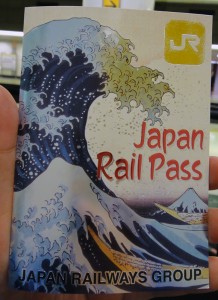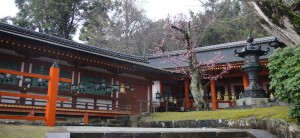My wife and I went to Japan for vacation in April 2012 and had a really great time there. We live in Australia and neither of us can speak Japanese further than “arigatou” or “sumimasen”. Yet we somehow survive a week vacation there in self-exploration itinerary. This article is about our experience, hoping that we can help other English-speaking travelers who plan to visit Japan anytime soon.

JAPAN (1 Apr – 9 Apr 2012)
KYOTO: Fushimi Inari Shrine, Kinkakuji*, Ginkakuji, Heian Jingu, Kiyomizu-dera Temple, Nijo Castle
NARA: Todaiji Temple, Nara National Park, Kasuga Grand Shrine
OSAKA: Osaka Station, Umeda Sky Building
TOKYO: Shibuya, Harajuku, Akihabara, Tokyo Tower, Asakusa, Sumida River
Preparation
A good preparation reparation is very important to travel to a country where not many people speak English. I started my preparation by the help of Google search to find cities and places I want to visit. Subsequently, I found this website www.japan-guide.com and decided to use it as my primary reference. After few weeks of preparation, I ended up creating a step-by-step itinerary that consists of 50 pages. Later on, I realized that this exhaustive guide is not really doable. But my “research process” in creating that 50 pages plan does really help.
The best season to visit Japan is (arguably) spring. Hoping to see a lot of cherry blossoms, my wife and I decided to set our schedule on early April as some internet research suggested it as the best week for cherry blossoms. Of course, this timing also have the bad side. Being a high season, everything is generally more expensive during this period, from flight cost to hotel accommodation.
I read a lot about capsule-sized cheap accommodation or overnight stay in love hotels as cheap alternative to stay in Japan. I decided not to do this, and choose more “conventional” hotels instead. As it was my first experience in Japan, I wanted it to be smooth, minimizing the surprise factor that might come from cheaper accommodation.
Japan is a cash society. So cash money is the primary method of payment there. Yes, some major stores accept credit cards, but if you expect to explore Japan in a more traditional ways, going to places where locals go, then cash is a better option.
As you might already know, international roaming is expensive. Especially if you are a heavy user of smartphone like myself. Considering that tourists can NOT purchase a prepaid SIM card in Japan, then you will need to arrange something else to be able to communicate while in Japan. For my case, in Australia they sell a lot of so-called “global SIM cards” which basically a UK mobile number that offers cheaper roaming costs. Since I’m going to need this SIM card for emergency contact, I decided to go with that one.
 Internet is a different issue. Neither of international roaming and global SIM card offer reasonable cost of mobile internet. So I decided to rent a mobile wifi router that will allow me to have unlimited internet in Japan, and the connection can be shared between up to 5 devices. A website called JapanMobileRental offers this mobile wifi rental at only 1,200 yen per day all inclusive, it sounds like a good solution for me.
Internet is a different issue. Neither of international roaming and global SIM card offer reasonable cost of mobile internet. So I decided to rent a mobile wifi router that will allow me to have unlimited internet in Japan, and the connection can be shared between up to 5 devices. A website called JapanMobileRental offers this mobile wifi rental at only 1,200 yen per day all inclusive, it sounds like a good solution for me.
Alternatively, you can also rent a Japanese SIM card from Softbank for 105 yen per day. But all calls, messages and internet are charged on top of this daily rental fee. I was seriously considering this option, but then I read something about iPhone bug that makes iMessages from other people are sent to the SIM card that once entering our iPhone, then I decided not to rent SIM card. If you use smartphone other than iPhone, you might want to consider this option.
For transportation, I purchased something called Japan Rail Pass that will give me unlimited rides on JR trains all across Japan for 7 days. This pass is exclusively for tourists. Local Japanese people can not buy this pass for themselves. The “pass” is a bit pricey, but I suppose it will simplify things as we will be able to visit a lot of places on fix cost, and it was in my plan that we are not going to use taxi at all in Japan.
note : you can click on any image to view the photo in bigger resolution
Departure
We flied to Japan on Cathay Pacific, with few hours transit/transfer in Hong Kong. Arrived in HKIA at 10pm, we faced our first problem that we didn’t plan before, most of the shops were closed already. And we had difficult time finding something to eat. Later on we also discovered that airport map that is available for free there is not quite accurate, especially in marking the locations of restaurants. If you have enough time, just quickly walk around to see your options rather than spending time trying to understand the map.
 Next lesson, waiting for our flight at 1am past midnight is a difficult task to do when you are extremely sleepy and tired after the previous flight. In our plan, we only need to survive until 1am, then we can sleep on the next flight. Turned out that our flight was delayed, and we ended spending more time in HKIA, trying our best not to fall asleep. Lucky they have free wifi internet, so I can keep myself busy with Facebook and Foursquare check-ins. Next time, I’ll have to make sure that transit time should not be around midnight.
Next lesson, waiting for our flight at 1am past midnight is a difficult task to do when you are extremely sleepy and tired after the previous flight. In our plan, we only need to survive until 1am, then we can sleep on the next flight. Turned out that our flight was delayed, and we ended spending more time in HKIA, trying our best not to fall asleep. Lucky they have free wifi internet, so I can keep myself busy with Facebook and Foursquare check-ins. Next time, I’ll have to make sure that transit time should not be around midnight.
Day 1
We arrived at Narita Airport – Terminal 2 at 6am. With tired body, we collected our luggage, did the long queue at immigration, and finally can start our vacation !
 First challenge, we need to figure out where we are supposed to collect the mobile wifi router that I already booked (and fully paid). The first counter we found at arrival hall is Softbank counter, so if I decided to rent SIM card from Softbank, I can easily collect it. But that was not my case. So we approached an “information” counter trying to ask direction to the JapanMobileRental counter with the little map we printed out from a booking confirmation email.
First challenge, we need to figure out where we are supposed to collect the mobile wifi router that I already booked (and fully paid). The first counter we found at arrival hall is Softbank counter, so if I decided to rent SIM card from Softbank, I can easily collect it. But that was not my case. So we approached an “information” counter trying to ask direction to the JapanMobileRental counter with the little map we printed out from a booking confirmation email.
Turned out that the JMR counter is located at departure hall, not arrival hall. So we need to go up few floors, found the departure hall, and finally located the JMR counter. A bit far from the arrival hall, but I suppose it will come in handy because we need to return it before we go home later.
 My wife stopped at a small gift shop near departure hall when she saw some very well-presented food. We bought some onigiri (rice balls) for our breakfast. And it was good ! It tasted really really good !
My wife stopped at a small gift shop near departure hall when she saw some very well-presented food. We bought some onigiri (rice balls) for our breakfast. And it was good ! It tasted really really good !
Next thing we need to do is trying to find the train station of JR Narita Express. It was located in lower floor and should be easy to find if you just follow the directions. We need to exchange our Japan Rail Pass Vouchers that we bought from Australia with the actual Japan Rail Pass cards. After looking around, I found the counter and tried to ask an officer there. Here comes the first surprise. Instead of answering my question, he scolded me with a very loud voice and talked really fast in Japanese. Later on I managed to understand that I was queuing at the wrong line. Still does not justify why he must scold me that way, I’m a tourist, for goodness’ sake ! And that man is working in a counter of an international airport, certainly I’m not the first tourist he ever saw.
 From 5 people in the counter, apparently there is only one man that can speak English. And by “can speak” I mean very minimum communication. And so we received our Japan Rail Pass cards and we book our seats in JR Narita Express and for JR Tokaido Hikari shinkansen from Tokyo to Kyoto.
From 5 people in the counter, apparently there is only one man that can speak English. And by “can speak” I mean very minimum communication. And so we received our Japan Rail Pass cards and we book our seats in JR Narita Express and for JR Tokaido Hikari shinkansen from Tokyo to Kyoto.
The ticket was very small. Took me a while to understand the meaning of those numbers in the tickets. They have ticket gates in the entrance and exit of every station and people just need to enter their ticket to the automatic gate machine. Since our tickets are special (from Japan Rail Pass, which basically only for tourists), apparently those automatic gates does not open when we entered our tickets. So we have to approach the manned gate, show them our Japan Rail Pass, and they allowed us to go through. Later on, this is always the case. Wherever we go, we only need to find the manned gate (usually located on the left-most or the right-most), show them our Japan Rail Pass, and get through.
 So we waited in the train platform. There is a digital display showing the name and direction of each train that arrives. The display shows the train name in kanji letters and in romaji alternatively (romaji is Japanese term for alphabetical letters that we normally use). So if you see a display only shows Japanese letters, no need to panic, just wait for few seconds and it will show you the “English” version. Make sure that you won’t enter the wrong train. To make it easier for us, there are also some digital display on the train. So we can always check the train name and direction before entering.
So we waited in the train platform. There is a digital display showing the name and direction of each train that arrives. The display shows the train name in kanji letters and in romaji alternatively (romaji is Japanese term for alphabetical letters that we normally use). So if you see a display only shows Japanese letters, no need to panic, just wait for few seconds and it will show you the “English” version. Make sure that you won’t enter the wrong train. To make it easier for us, there are also some digital display on the train. So we can always check the train name and direction before entering.
The JR Narita Express arrived and I tried to make sure that it was the right train by asking an officer there. Knowing that English won’t help much here, I showed him my ticket instead. Apparently he can speak few words of Engish and he told me that my seat is located at the front car (we were waiting near the entrance of the rear car) and there will be no time to walk towards the front car since the train only stop for few seconds. And so he suggested us to just hop on the rear car and find any seat that is empty. Note : the word “car” here is actually a train carriage, not sure whether Japanese use “car” as shortened version of carriage, or they actually mean “car”.
 Inside the train was a very clean interior. We have dedicated space where we can put our luggages. And optionally we can even lock it using 3 digits number code that we can set ourselves. But apparently no one is using that lock, and so we decided to follow what other people do.
Inside the train was a very clean interior. We have dedicated space where we can put our luggages. And optionally we can even lock it using 3 digits number code that we can set ourselves. But apparently no one is using that lock, and so we decided to follow what other people do.
We found empty seats. To my surprise, it has electric plug, which is very good as I need to recharge my phones and other electronic devices that need some juice after a long flight.
A man in uniform came to check our tickets and was confused why we did not sit on our “booked” seats. I tried to explain, in English, and I don’t think he understand a word that I was saying. As soon as I start my first word in English, he just said “daijobu” (means it’s ok), bow lightly and left us. I guess letting us stay is easier for him rather than trying to communicate with us.
 Then we arrived at Tokyo station. I read in many blogs that Tokyo station is reasonably big station that often confuses tourists. I personally find that there are enough signs in English there. Yellow signs usually show directions; blue signs usually show train platforms. There were some stores selling lunch boxes in the station (usually called ekiben, eki = train, ben = bentou, food in box) and we decided to try one. Basic question, we need to know whether we can eat this in the shinkansen or not (in Australia we can eat in train, but I know some countries like Singapore doesn’t allow train passengers to eat or drink).
Then we arrived at Tokyo station. I read in many blogs that Tokyo station is reasonably big station that often confuses tourists. I personally find that there are enough signs in English there. Yellow signs usually show directions; blue signs usually show train platforms. There were some stores selling lunch boxes in the station (usually called ekiben, eki = train, ben = bentou, food in box) and we decided to try one. Basic question, we need to know whether we can eat this in the shinkansen or not (in Australia we can eat in train, but I know some countries like Singapore doesn’t allow train passengers to eat or drink).
 My wife tried to ask a train gate officer whether we can eat in shinkansen or not. Again, her attempt was a total failure because of the English usage. The officer answered with a polite smile plus some body language. We didn’t understand what he was trying to tell. Desperate, I tried to ask the shopkeeper “sumimasen, can I eat this in the shinkansen?” while pointing at one of the ekiben, then pointing at shinkansen sign, and making body language of “eating”. The shop lady smiled and answered “yes, can eat”. Finally ! An answer ! And so I picked up the most interesting-looking box with some components that I don’t even have any idea what those are. For your reference, those ekiben generally costs between 600 to 1500 yen. A choice of something between 800 to 1000 yen will generally get you a decent one.
My wife tried to ask a train gate officer whether we can eat in shinkansen or not. Again, her attempt was a total failure because of the English usage. The officer answered with a polite smile plus some body language. We didn’t understand what he was trying to tell. Desperate, I tried to ask the shopkeeper “sumimasen, can I eat this in the shinkansen?” while pointing at one of the ekiben, then pointing at shinkansen sign, and making body language of “eating”. The shop lady smiled and answered “yes, can eat”. Finally ! An answer ! And so I picked up the most interesting-looking box with some components that I don’t even have any idea what those are. For your reference, those ekiben generally costs between 600 to 1500 yen. A choice of something between 800 to 1000 yen will generally get you a decent one.
We can easily find the platform of our shinkansen. This time, we are smarter, we already figured out that some numbers in our ticket indicates the car number of our train, so we looked at the right entrance of our car number and started to queue there. Japanese people queue very patiently ! None of them tried to break the queue or trying to cheat their waiting time. Since we were early, we got the first place in the queue. Within few minutes, more and more people are start queuing behind us.
 A train arrived. I checked the time and it was not the time for our train yet (train schedule is really punctual in Japan, so we can actually rely on the time). So I told my wife that it’s probably not our train. Fortunately, a Japanese lady behind us told us “Hikari shinkansen” while pointing at the train. I checked the train’s display (this one is not digital) saw “Hikari” and “Shin-Osaka” sign there. Apparently it was actually our train ! That lady must have heard my conversation with my wife earlier and I did tell my wife we need to catch Hikari train to Shin-Osaka. That’s very nice of her to tell us then. Drastically improved my impression of Japanese people again, after receiving the shocking scold treatment earlier.
A train arrived. I checked the time and it was not the time for our train yet (train schedule is really punctual in Japan, so we can actually rely on the time). So I told my wife that it’s probably not our train. Fortunately, a Japanese lady behind us told us “Hikari shinkansen” while pointing at the train. I checked the train’s display (this one is not digital) saw “Hikari” and “Shin-Osaka” sign there. Apparently it was actually our train ! That lady must have heard my conversation with my wife earlier and I did tell my wife we need to catch Hikari train to Shin-Osaka. That’s very nice of her to tell us then. Drastically improved my impression of Japanese people again, after receiving the shocking scold treatment earlier.
 Few seconds later, the train doors were opened. As we were in front of the queue, me and my wife stepped inside the train. Suddenly a man came to us, speaking Japanese very fast with loud voice. As I didn’t understand a word that he’s saying, I tried to ask him what’s wrong (in English). He looked confused when I asked in English. At least now he must understand that I don’t understand what he was saying. Then after few more attempts to communicate with me in Japanese (which obviously didn’t work), he finally found one English word that I can understand : “cleaning”. He’s a cleaning officers to clean the train interiors. So the doors were opened to give ways for cleaners to do their work. Passengers are supposed to wait outside first until they are finished. And so we walked out of the train with a bit of embarrassment. But then again, how are we supposed to know that? There is no sign that we can’t enter yet. The nice lady who helped us earlier smiled a bit when she saw us back in the queue.
Few seconds later, the train doors were opened. As we were in front of the queue, me and my wife stepped inside the train. Suddenly a man came to us, speaking Japanese very fast with loud voice. As I didn’t understand a word that he’s saying, I tried to ask him what’s wrong (in English). He looked confused when I asked in English. At least now he must understand that I don’t understand what he was saying. Then after few more attempts to communicate with me in Japanese (which obviously didn’t work), he finally found one English word that I can understand : “cleaning”. He’s a cleaning officers to clean the train interiors. So the doors were opened to give ways for cleaners to do their work. Passengers are supposed to wait outside first until they are finished. And so we walked out of the train with a bit of embarrassment. But then again, how are we supposed to know that? There is no sign that we can’t enter yet. The nice lady who helped us earlier smiled a bit when she saw us back in the queue.
 After waiting, then finally we can actually enter the train and started our journey to Kyoto. It was a nice 2.5 hours journey. We had our lunch in the train, enjoying our first experience of eating ekiben. Apparently most of other passengers are also eating, maybe because it was lunch time. And then we had our time to actually rest after being so tired after the midnight flight delay. My wife and I took turn to have a power-nap, and it did help restoring some of energy.
After waiting, then finally we can actually enter the train and started our journey to Kyoto. It was a nice 2.5 hours journey. We had our lunch in the train, enjoying our first experience of eating ekiben. Apparently most of other passengers are also eating, maybe because it was lunch time. And then we had our time to actually rest after being so tired after the midnight flight delay. My wife and I took turn to have a power-nap, and it did help restoring some of energy.
 Arrived at Kyoto station. We found our way to the exit gate and started searching for our Daiwa Roynet Hotel. It didn’t took us long to find the place. It was quite near from the station, and we didn’t have any problem carrying our heavy luggage from station to the hotel.
Arrived at Kyoto station. We found our way to the exit gate and started searching for our Daiwa Roynet Hotel. It didn’t took us long to find the place. It was quite near from the station, and we didn’t have any problem carrying our heavy luggage from station to the hotel.
The hotel receptionists are also only speak limited English except for one person that seems to be more fluent. Anyway, not a big deal since I have booked everything. Showed them my hotel voucher, my passport, received the keys and everything’s done. It was around 3pm at that time and we were behind all schedules in our itinerary for day one. Well, can’t help it. We learnt our lesson not to put so much itinerary for day one after long flight.
 Given the available time and the remaining strength that we have left, we decided to change the whole schedule. We dropped our plan to visit Ginkakuji, Eikando, Nanzenji and Heian Jingu on first day and decided to go to Fushimi Inari Shrine, mainly because it is located near our hotel, reachable by train, only two stops ahead. And so we returned to Kyoto Station and took the train towards Nara (JR Nara Express) at platform 8, 9 or 10. We stopped at Inari Station, and immediately can find the shrine within walking distance.
Given the available time and the remaining strength that we have left, we decided to change the whole schedule. We dropped our plan to visit Ginkakuji, Eikando, Nanzenji and Heian Jingu on first day and decided to go to Fushimi Inari Shrine, mainly because it is located near our hotel, reachable by train, only two stops ahead. And so we returned to Kyoto Station and took the train towards Nara (JR Nara Express) at platform 8, 9 or 10. We stopped at Inari Station, and immediately can find the shrine within walking distance.
 The Fushimi Inari Shrine is strikingly clean and beautiful. It is famous for having thousands of Torii gates behind its main building (Torii gates is a usually-colored-orange gates at Shinto shrines). Each torii has Japanese kanji written on it, too bad I can’t read them. Everything was so unique and different. And the shrine itself felt really “grand”.
The Fushimi Inari Shrine is strikingly clean and beautiful. It is famous for having thousands of Torii gates behind its main building (Torii gates is a usually-colored-orange gates at Shinto shrines). Each torii has Japanese kanji written on it, too bad I can’t read them. Everything was so unique and different. And the shrine itself felt really “grand”.
 In one of the shrines, we saw some shrine priestess (usually called miko) doing some ritual. It was the first time I saw real miko. Took a photo of them, a lot of other visitors were doing the same, until one of them told us to step back and not to take photo.
In one of the shrines, we saw some shrine priestess (usually called miko) doing some ritual. It was the first time I saw real miko. Took a photo of them, a lot of other visitors were doing the same, until one of them told us to step back and not to take photo.
We spent some time walking through the torii gates path at the back, took lots of photos and enjoyed the scenes. Before going back to the hotel, we found a taiyaki stall and tried. Again, with very limited Japanese plus some body language gestures, I managed to buy two taiyaki, and it was really yummy! I should have ordered more.
 Going back to the Kyoto Station was relatively simple since Inari Station is a small station. Back in Kyoto, we searched for dinner and our choice went to a small curry shop near the station. The picture outside looks good and so far we survived anyway without proper Japanese language, so why not, we agreed to have curry for dinner. We didn’t think that ordering dinner could be an interesting experience for us.
Going back to the Kyoto Station was relatively simple since Inari Station is a small station. Back in Kyoto, we searched for dinner and our choice went to a small curry shop near the station. The picture outside looks good and so far we survived anyway without proper Japanese language, so why not, we agreed to have curry for dinner. We didn’t think that ordering dinner could be an interesting experience for us.
 We entered the shop and sit on an empty seat. Then a man came to us speaking in Japanese. Seeing that I look confused, he pointed at a machine near the shop entrance. Still a bit puzzled, I moved to the machine, and turned out that we are supposed to choose our order there by pressing few buttons, put our money, receive our change and receive a small “food ticket”. Then we need to give the food ticket to them and receive our food. And so we spent few minutes to figure out how the machine works. We basically need to enter our money first, then menus with prices lower or equal than the money we inserted will be highlighted. We choose the menu by pressing it. Then we need to press a big green button to “finalize” our transaction. We will receive our ticket and change, and we need to repeat the process again for ordering the next menu.
We entered the shop and sit on an empty seat. Then a man came to us speaking in Japanese. Seeing that I look confused, he pointed at a machine near the shop entrance. Still a bit puzzled, I moved to the machine, and turned out that we are supposed to choose our order there by pressing few buttons, put our money, receive our change and receive a small “food ticket”. Then we need to give the food ticket to them and receive our food. And so we spent few minutes to figure out how the machine works. We basically need to enter our money first, then menus with prices lower or equal than the money we inserted will be highlighted. We choose the menu by pressing it. Then we need to press a big green button to “finalize” our transaction. We will receive our ticket and change, and we need to repeat the process again for ordering the next menu.
 The curry was very good ! We went back to our hotel with tired legs and happy tummy.
The curry was very good ! We went back to our hotel with tired legs and happy tummy.
That night I revisited again our whole plan for Kyoto and re-plan the whole itinerary (mostly since we did not get to see few places that was originally planned for day one).
 It might worth mentioning that Japan has some very unique toilet seating unit. Our hotel room turned out to have that unique toilet, so I thought you can see it yourself from the photo.
It might worth mentioning that Japan has some very unique toilet seating unit. Our hotel room turned out to have that unique toilet, so I thought you can see it yourself from the photo.
Day 2
We started our second day with a nice breakfast at the hotel. Breakfast was not included in our hotel room cost, but since it only costs 1000 yen per person to enjoy the breakfast buffet, we decided to try it.
 The buffet was a combination of east-west experience. You get to eat Japanese-style breakfast there; or you can choose something “safe” like scrambled egg, bacon and sausages. I went with… a little bit of everything. One thing to mention here is that not all Japanese food are what it looks like. I picked something that I thought was pudding, turned out it was tofu. Something else that looked like tofu turned out to be… until today I don’t know what that is.
The buffet was a combination of east-west experience. You get to eat Japanese-style breakfast there; or you can choose something “safe” like scrambled egg, bacon and sausages. I went with… a little bit of everything. One thing to mention here is that not all Japanese food are what it looks like. I picked something that I thought was pudding, turned out it was tofu. Something else that looked like tofu turned out to be… until today I don’t know what that is.
Our hotel booking comes with a free half-day Kyoto tour. So we walked to the meeting point in the morning to join our half-day guided tour. The promised itinerary for this guided tour was to visit Kyoto Imperial Palace, Nijo Castle, Kinkakuji and Kyoto Handicraft Center. Places we actually visited was a bit different.
 The guided tour started by visiting Honganji temple instead of Kyoto Imperial Palace. Apparently the palace is closed on that day. It was raining quite heavily that morning and I think the tour guide picked up a tourism spot with indoor viewing. Honganji temple is an old Buddhist temple. We get to see what’s inside the temple instead of just looking at the building from outside.
The guided tour started by visiting Honganji temple instead of Kyoto Imperial Palace. Apparently the palace is closed on that day. It was raining quite heavily that morning and I think the tour guide picked up a tourism spot with indoor viewing. Honganji temple is an old Buddhist temple. We get to see what’s inside the temple instead of just looking at the building from outside.
 Next we go to Nijo Castle. An actual castle that was used by Shogun Tokugawa in Japan history. We get to see inside the castle, but we are not allowed to take any photo. First thing that everyone noticed when entering the castle main building is that the floor has some squeaking sound every time we step on it. We learn that it was intentionally built that way (using some construction method) as a form of security alarm back in the past. When an enemy sneaked in, guards will be able to tell from the sound.
Next we go to Nijo Castle. An actual castle that was used by Shogun Tokugawa in Japan history. We get to see inside the castle, but we are not allowed to take any photo. First thing that everyone noticed when entering the castle main building is that the floor has some squeaking sound every time we step on it. We learn that it was intentionally built that way (using some construction method) as a form of security alarm back in the past. When an enemy sneaked in, guards will be able to tell from the sound.
There were a lot of diorama inside the main building. Some sort like museum, I guess. As much as we had fun inside the building, we still haven’t got a lot of good photos since it was still raining outside and photo taking is not allowed inside.
 From Nijo Castle, we visited Kinkakuji (or also famous as The Golden Pavilion). It’s a small pavilion located on a lake, surrounded by water, and the walls are covered by actual gold. The one that exists today is just a replica by the way. The original one was burnt, twice in the past, then the government decided to rebuild it exactly like the original. This place is one highlight I was most excited about, and when we were there it was still raining. Everyone brings umbrella, making it hard just to see the Kinkakuji clearly, plus some foggy weather we had there. Got some photos, but not quite satisfied.
From Nijo Castle, we visited Kinkakuji (or also famous as The Golden Pavilion). It’s a small pavilion located on a lake, surrounded by water, and the walls are covered by actual gold. The one that exists today is just a replica by the way. The original one was burnt, twice in the past, then the government decided to rebuild it exactly like the original. This place is one highlight I was most excited about, and when we were there it was still raining. Everyone brings umbrella, making it hard just to see the Kinkakuji clearly, plus some foggy weather we had there. Got some photos, but not quite satisfied.
The Kyoto Handicraft Center that is promised in the itinerary were not visited. The bus just passed through there when the tour guide explained few things about the place, and that’s it ! Overall it was a very disappointing guided tour, with a tour guide that barely can speak English (his pronunciation is very bad and it’s hard to understand his sentences, so I just totally ignored his explanation throughout the tour). I was really glad that we planned most of this vacation by self exploration itinerary instead of guided tours.
 After the rainy morning guided tour, we went back to Kyoto station to start our afternoon plan. Again we bought ekiben at Kyoto Station and walked towards platform 8, 9, 10 to catch a JR Nara train to Nara. From Nara Station, we walked East according to map I had prepared before. With GPS in my iPhone, things did get a lot easier.
After the rainy morning guided tour, we went back to Kyoto station to start our afternoon plan. Again we bought ekiben at Kyoto Station and walked towards platform 8, 9, 10 to catch a JR Nara train to Nara. From Nara Station, we walked East according to map I had prepared before. With GPS in my iPhone, things did get a lot easier.
I find that Japanese people in Kyoto are very polite. In a train, when they want to sit in front of us, they will bow slightly and said “sumimasen” before moving towards the seat. This nice gesture is nowhere to be found later in Tokyo.
 Thus said, 40 minutes of walking uphill was more than I expected. The first destination is Todaiji Temple where big Buddha statues can be found there. Nara area is famous for having deers roaming around freely. As we can clearly saw that as we walked closer to the temple. More and more deers. You might want to watch your step as I’m sure you don’t want to step on something those deers left behind ^_^
Thus said, 40 minutes of walking uphill was more than I expected. The first destination is Todaiji Temple where big Buddha statues can be found there. Nara area is famous for having deers roaming around freely. As we can clearly saw that as we walked closer to the temple. More and more deers. You might want to watch your step as I’m sure you don’t want to step on something those deers left behind ^_^
 Entering the temple costs 500 yen per person, but it was worth it ! There were some souvenir shops inside the temple, and their price is the cheapest I found so far. Better deal than buying the same things from Kyoto Station or the previous temples we have visited. Right before we planned to continue our walk, the rain fell really heavily, so we decided to stay a bit longer, and… do some more shopping.
Entering the temple costs 500 yen per person, but it was worth it ! There were some souvenir shops inside the temple, and their price is the cheapest I found so far. Better deal than buying the same things from Kyoto Station or the previous temples we have visited. Right before we planned to continue our walk, the rain fell really heavily, so we decided to stay a bit longer, and… do some more shopping.
 From Todaiji, we went to Kasuga Taisha (Grand Shrine), located around 20 minutes walk in South-East direction. I started to get the feel that they always have Buddhist temple and Shinto Shrine in nearby locations somehow. Kasuga was also a great spot. 500 yen admission fee per person. There were lots of golden bells inside, looked very good as photo background.
From Todaiji, we went to Kasuga Taisha (Grand Shrine), located around 20 minutes walk in South-East direction. I started to get the feel that they always have Buddhist temple and Shinto Shrine in nearby locations somehow. Kasuga was also a great spot. 500 yen admission fee per person. There were lots of golden bells inside, looked very good as photo background.
An interesting fact was that we met the tour leader from that morning with our morning group at Kasuga. Since we only got “half day guided tour”, our tour finshed by noon while most of other group members were paying for full day tour. Hahaha, I still remember the tour guide’s surprised face as he saw us there. Felt bad for the tour members there as they paid expensive tour cost only to hear explanations in a very bad English while we can explore the same tourism spots for free.
 On the way back to the station, we went past Nara National Museum and took few quick shots there. Then we visited Kokufuji Temple which turned out that its Central Golden Hall was under construction (I later Googled and discovered that the reconstruction is scheduled to finish by October 2018). Anyway, we still got to see some of Kokufuji. If you like pagoda-shaped temples, than this is one of a recommended view you need to see.
On the way back to the station, we went past Nara National Museum and took few quick shots there. Then we visited Kokufuji Temple which turned out that its Central Golden Hall was under construction (I later Googled and discovered that the reconstruction is scheduled to finish by October 2018). Anyway, we still got to see some of Kokufuji. If you like pagoda-shaped temples, than this is one of a recommended view you need to see.
Right across Kokufuji, we find a beautiful pond (I think the name is Sarusawa pond, but I’m not quite sure) with some locals doing some light exercise. Then we walked through Nara Shopping Street and had okonomiyaki for dinner.
 We found the courage to enter the restaurant because they put some displays with English names in front of them. But once we were inside, once again we need to use body language (pointing at the food’s photo) to order. Best of all, they have a restroom inside the restaurant. Quite something important after a long walk.
We found the courage to enter the restaurant because they put some displays with English names in front of them. But once we were inside, once again we need to use body language (pointing at the food’s photo) to order. Best of all, they have a restroom inside the restaurant. Quite something important after a long walk.
The okonomiyaki was superb ! I have tried okonomiyaki in some different countries and they were nothing close compared to this one ! Well I guess that’s just natural as Japan is the originating country of this wonderful dish.
From Nara Station, we went back to Kyoto Station. In train stations, I started to get the hang of asking for direction already. Just say “sumimasen… <station name of our destination>-eki wa doko desu ka?” and they will point out the platform for the train, or at least telling the platform number using their fingers. I know that my question is not grammatically correct, but it does the trick and I always get the answer that I need =) In case you need it for reference, go to platform 4 in Nara Station to catch train to Kyoto.
Day 3
 Since we love yesterday’s breakfast, we ended up paying for the hotel buffet once again. This time we already learn from yesterday’s mistakes and ended up choosing better food =)
Since we love yesterday’s breakfast, we ended up paying for the hotel buffet once again. This time we already learn from yesterday’s mistakes and ended up choosing better food =)
We went to Kyoto Station again, towards North to find Bus Terminal. There you can find a ticketing office and we bought “Kyoto City Bus One Day Card” which gives us unlimited bus rides within most part of city area for 500 yen per person. A good way to save cost to a single destination since one bus ride will normally cost you 220 yen, so a return trip will cost 440 yen already. I probably need to mention that there are some areas that are not covered by this card, but unless you are planning to go a bit far from Kyoto City, this card should be able to get you to most tourist destinations.
 Then we queued on the line for bus number 100. In Kyoto, people entered buses from the back door and later exit from the front door. Once inside, there was a monitor that display the name of the next stop and tourist destinations near that stop. So most probably you won’t miss your stop unless you are really not paying attention.
Then we queued on the line for bus number 100. In Kyoto, people entered buses from the back door and later exit from the front door. Once inside, there was a monitor that display the name of the next stop and tourist destinations near that stop. So most probably you won’t miss your stop unless you are really not paying attention.
Our first stop was Gojozaka stop. Before exiting the bus, we need to put our unlimited bus pass into a machine. The bus driver said “arigatou gozaimasu” (thank you) to each and every person going out (by either paying in cash or using card) so you can imagine how many “thank you” he must say in a day. This is an unusual habit for me, but I find it quite interesting.
 From Gojozaka stop, we walked towards Kiyomizu-dera Temple. The road was very crowded with shops and people. We planned to visit this temple early in the morning, but I guess we were not the only ones with the idea.
From Gojozaka stop, we walked towards Kiyomizu-dera Temple. The road was very crowded with shops and people. We planned to visit this temple early in the morning, but I guess we were not the only ones with the idea.
Kiyomizu-dera Temple is a really huge and popular temple. The admission fee is 300 yen. It has many points of interest and you can certainly took lots of great photos there. Some part of the temple is currently under renovation, but they are smart enough to paint the renovated location using the same color as the rest of the temple so it doesn’t affect the overall feeling when we looked at the temple from afar.
 On the way back to the bus stop, we stopped to buy something interesting. A steamed bun with an interesting filling : sakura paste. It was not superb, but I like it.
On the way back to the bus stop, we stopped to buy something interesting. A steamed bun with an interesting filling : sakura paste. It was not superb, but I like it.
To explore different routes, we went to Kiyomizu-michi Bus Stop rather than returning Gojozaka Bus Stop. There is an iPhone app called Kyoto Bus that will help you with the location and bus stops and the routes. It has explanations in English, and could be very handy in location because we can easily track our location with GPS.
 From Kiyomizu-michi Stop, we took bus number 100 again towards Heian Shrine. There is a bus route information at the stop, with English letters, so you might need to check it out first to make sure that you take the bus to the right direction, not the other way around.
From Kiyomizu-michi Stop, we took bus number 100 again towards Heian Shrine. There is a bus route information at the stop, with English letters, so you might need to check it out first to make sure that you take the bus to the right direction, not the other way around.
 You won’t miss the stop for Heian Shrine since there will be a display in the bus and there will be a huge torii gate near the bus stop. Heian Shrine is another great shrine, and the main area is free to enter. from Heian Shrine, we returned to the same bus stop and got on bus number 100 again towards Ginkakuji (Silver Pavilion).
You won’t miss the stop for Heian Shrine since there will be a display in the bus and there will be a huge torii gate near the bus stop. Heian Shrine is another great shrine, and the main area is free to enter. from Heian Shrine, we returned to the same bus stop and got on bus number 100 again towards Ginkakuji (Silver Pavilion).
 From Ginkakuji-mae Stop, Ginkakuji can be reached by walking. Again, crowded with people and shops. There is a public toilet there and it was reasonably clean. According to my wife, the female restroom does not have sanitary disposal or syringes disposal. So if you need those two facilities, perhaps need to prepare something more.
From Ginkakuji-mae Stop, Ginkakuji can be reached by walking. Again, crowded with people and shops. There is a public toilet there and it was reasonably clean. According to my wife, the female restroom does not have sanitary disposal or syringes disposal. So if you need those two facilities, perhaps need to prepare something more.
 Unlike Kinkakuji (Golden Pavilion) which actually use real gold, Ginkakuji does not actually use real silver for the main building. It’s just the name. Admission fee is 500 yen. After spending some time at Ginkakuji, our choice of lunch is a soba restaurant near the location. We ordered some soba and udon (Japanese noodle) with hot ocha (hot Japanese tea). It was a satisfying lunch !
Unlike Kinkakuji (Golden Pavilion) which actually use real gold, Ginkakuji does not actually use real silver for the main building. It’s just the name. Admission fee is 500 yen. After spending some time at Ginkakuji, our choice of lunch is a soba restaurant near the location. We ordered some soba and udon (Japanese noodle) with hot ocha (hot Japanese tea). It was a satisfying lunch !
Philosopher’s Path, a road right in front of Ginkakuji area is a famous spot for enjoying sakura (cherry blossoms) flower in spring. But when we got there, the flowers had not started to bloom yet. Apparently, this year’s spring come a bit late for Japan =(
 From Ginkakuji, we decided to revisit Kinkakuji once again (we considered our earlier visit was a failure due to the rain). We took bus number 102 that will take us from Ginkakuji to Kinkakuji. Be careful in finding the bus stop as bus 100 and bus 102 has different stop locations. Again, the Kyoto Bus iPhone app should be able to help with good GPS accuracy.
From Ginkakuji, we decided to revisit Kinkakuji once again (we considered our earlier visit was a failure due to the rain). We took bus number 102 that will take us from Ginkakuji to Kinkakuji. Be careful in finding the bus stop as bus 100 and bus 102 has different stop locations. Again, the Kyoto Bus iPhone app should be able to help with good GPS accuracy.
 Bus 102 has schedule around once every 30 minutes, so you might want to check the schedule first before heading to the bus stop. My wife and I ended up waiting around 25 minutes and later we realized that we could have spent the 25 minutes better by browsing around there.
Bus 102 has schedule around once every 30 minutes, so you might want to check the schedule first before heading to the bus stop. My wife and I ended up waiting around 25 minutes and later we realized that we could have spent the 25 minutes better by browsing around there.
From bus 102, we stopped at Kinkakuji-michi Stop then walked towards Kinkakuji. It was a splendid decision to revisit. Day three’s weather is clear and sunny. And we ended up with lo lot better photos of this beautiful place. Ah yes, before I forget, the admission fee is 400 yen. On the way back to bus stop, we bought wasabi peanuts and some dango (Google it if you don’t know what dango is).
To return to Kyoto Station, we need to take bus number 205 from Kinkakuji. And so we did. Arrived back in Kyoto Station around 3pm and there was still enough time for one more location. Guess what? We decided to visit Osaka. To go there, we took JR Kyoto train and stopped at Osaka Station.
 Osaka gave a really different vibes from Kyoto. In Kyoto, I can feel a quite relaxed atmosphere, people are polite and nice to each other. In Osaka, we got the vibes of a big and metropolitan city. The train station itself was impressive and we almost got lost inside.
Osaka gave a really different vibes from Kyoto. In Kyoto, I can feel a quite relaxed atmosphere, people are polite and nice to each other. In Osaka, we got the vibes of a big and metropolitan city. The train station itself was impressive and we almost got lost inside.
After a lot of exploring, we found our way out of the station and heading to Umeda Sky Building. We did not enter the building, just taking some photos from some distance. The we head back to Osaka Station and search for dinner.
 The dinner of our choice was a nice looking restaurant. Since our earlier meals turned out to be cheaper that what we expected, we figured that we might have some to spare on a better dine experience. So we went in, prepared to pay whatever the cost they are going to have. I ordered a sushi set and my wife ordered don-soba set. It was to our surprise that it costs less than 3000 yen, a lot cheaper than what it would cost in Australia to get the same experience. I love Japanese dining !
The dinner of our choice was a nice looking restaurant. Since our earlier meals turned out to be cheaper that what we expected, we figured that we might have some to spare on a better dine experience. So we went in, prepared to pay whatever the cost they are going to have. I ordered a sushi set and my wife ordered don-soba set. It was to our surprise that it costs less than 3000 yen, a lot cheaper than what it would cost in Australia to get the same experience. I love Japanese dining !
Day 4
 We started the day by checking out from hotel, then walked towards Kyoto Station to catch shinkansen to Tokyo. One thing we did not prepared before was breakfast. In a rush to catch the shinkansen, we managed to buy two packs of ekiben after booking our seats.
We started the day by checking out from hotel, then walked towards Kyoto Station to catch shinkansen to Tokyo. One thing we did not prepared before was breakfast. In a rush to catch the shinkansen, we managed to buy two packs of ekiben after booking our seats.
 Arrived at Shinagawa Station after 2.5 hours journey (we did not go to Tokyo Station because our hotel is closer to Shinagawa Station) we were faced by our first puzzle, figuring out our location and the exit gate. Turned out that from the shinkansen platform (from Kyoto), we need to go towards North Gate first, then following signs to South Exit. They even have our hotel name (Shinagawa Prince Hotel) on the signs.
Arrived at Shinagawa Station after 2.5 hours journey (we did not go to Tokyo Station because our hotel is closer to Shinagawa Station) we were faced by our first puzzle, figuring out our location and the exit gate. Turned out that from the shinkansen platform (from Kyoto), we need to go towards North Gate first, then following signs to South Exit. They even have our hotel name (Shinagawa Prince Hotel) on the signs.
Stepping out from Shinagawa Station, we were greeted by Tokyo’s busy style and fast-walking people. Thanks to my wife, we managed to find the hotel’s main lobby through some mall-like entrance. Since it was still early in the morning, naturally we can not check in yet. So we left our luggages at the hotel and started our day four journey.
 One thing I managed to understand from my preparation is that Tokyo train has one route called Yamanote Line that goes round in circle. It covers most of our planned destination thus this line will come in handy. From Shinagawa Station, we catched JR Yamanote Line towards Shibuya, our first destination of the day. Inside the train, there is some display on the next station in Japanese letters and roman letter alternately. So again, you won’t miss your stop. You can even see the remaining minutes before arriving to a station.
One thing I managed to understand from my preparation is that Tokyo train has one route called Yamanote Line that goes round in circle. It covers most of our planned destination thus this line will come in handy. From Shinagawa Station, we catched JR Yamanote Line towards Shibuya, our first destination of the day. Inside the train, there is some display on the next station in Japanese letters and roman letter alternately. So again, you won’t miss your stop. You can even see the remaining minutes before arriving to a station.
 Just like many other people, the first thing to visit in Shibuya is the famous Hachiko (the loyal dog) statue. Even one of the exit gate from Shibuya Station is named “Hachiko Exit”. Next we walked around Shibuya area and decided to have lunch inside the 109 Building. It was the entire building for female clothes and accessories ! (they have the men’s building separately) I felt so out-of-place there. I wouldn’t dare to step in if I were not with my wife.
Just like many other people, the first thing to visit in Shibuya is the famous Hachiko (the loyal dog) statue. Even one of the exit gate from Shibuya Station is named “Hachiko Exit”. Next we walked around Shibuya area and decided to have lunch inside the 109 Building. It was the entire building for female clothes and accessories ! (they have the men’s building separately) I felt so out-of-place there. I wouldn’t dare to step in if I were not with my wife.
 Our choice of lunch was Japanese pasta. It was certainly better than Pasta de Waraku chain restaurants that I have tasted before in other countries. We ordered a set menu that includes yummy desserts ! A sweet energy to continue the day.
Our choice of lunch was Japanese pasta. It was certainly better than Pasta de Waraku chain restaurants that I have tasted before in other countries. We ordered a set menu that includes yummy desserts ! A sweet energy to continue the day.
From Shibuya, we took JR Yamanote train again towards Harajuku. One of our destination is the large Daiso store in Takeshita-dori (Takeshita Shopping Stree). Daiso is a store that sells a wide range of products for 100 yen price. And so we did some shopping at Daiso. Apparently, the actual price is 105 yen, not 100 yen, perhaps the additional 5 is tax or something.
 From Takeshita-dori we bought sweet crepes, then we walked towards Yoyogi Park, a huge green area just next to Harajuku Station. My initial plan is to go to a pond inside the park that looks really great from some photos I found from Google. After a long walk (Yoyogi Park is really really huge), I couldn’t find the park, and Google Map does not really help either since it only shows a huge green area with some water areas. I have no way to tell which water area is the one I was looking for.
From Takeshita-dori we bought sweet crepes, then we walked towards Yoyogi Park, a huge green area just next to Harajuku Station. My initial plan is to go to a pond inside the park that looks really great from some photos I found from Google. After a long walk (Yoyogi Park is really really huge), I couldn’t find the park, and Google Map does not really help either since it only shows a huge green area with some water areas. I have no way to tell which water area is the one I was looking for.
 In the searching process, we saw some signs that there’s a shrine nearby. Since we already walked a long way, we decided to visit this shrine. We learnt later that the shrine’s name is Meiji Shrine, and it was part of our next day’s itinerary. We just didn’t realize it before.
In the searching process, we saw some signs that there’s a shrine nearby. Since we already walked a long way, we decided to visit this shrine. We learnt later that the shrine’s name is Meiji Shrine, and it was part of our next day’s itinerary. We just didn’t realize it before.
Meiji Shrine was a shrine dedicated for Meiji Emperor. The emperor of Japan’s modernization. The place itself was quite nice. But since I have seen other “grand” temples and shrines, this one didn’t feel so “grand” for me. And so we returned to Harajuku Station, and took JR Yamanote train again towards Ueno Station to visit Ueno Park. Ueno Park is the next location where I expect I can see some sakura flowers.
 Arrived at Ueno Park at evening, we found a lot of locals are preparing for hanami (watching cherry blossoms). There were some food stalls, and lots of sakura flowers. Finally ! My primary reason of choosing this season for the trip was paid off !
Arrived at Ueno Park at evening, we found a lot of locals are preparing for hanami (watching cherry blossoms). There were some food stalls, and lots of sakura flowers. Finally ! My primary reason of choosing this season for the trip was paid off !
 There were signs everywhere that camera tripod was not allowed in the area (but camera without tripod is okay). In fact, many tourism places in Japan have this restriction. So if you travel alone, bringing tripod might not help so much in helping you to get nice photos of yourself. Asking people’s help to take photos for you might be a good idea.
There were signs everywhere that camera tripod was not allowed in the area (but camera without tripod is okay). In fact, many tourism places in Japan have this restriction. So if you travel alone, bringing tripod might not help so much in helping you to get nice photos of yourself. Asking people’s help to take photos for you might be a good idea.
And so we joined the locals in enjoying sakura blossoms. We bought oden and found an empty spot. It’s a priceless experience !
 Still in Ueno area, after exploring for a while, we found a small shrine on a small island in a pond. There were lots of food stalls around that shrine (bought some takoyaki from there). It was a festival-like atmosphere. And we loved it !
Still in Ueno area, after exploring for a while, we found a small shrine on a small island in a pond. There were lots of food stalls around that shrine (bought some takoyaki from there). It was a festival-like atmosphere. And we loved it !
We grabbed our dinner at 7 eleven near our hotel (and also bought some bread for the next day’s breakfast). They have microwave for us to heat the food we just buy (which is handy since later we found that our hotel room does not have microwave). One problem in buying food in Japan is that we need to ask whether they are supposed to be eaten hot or cold. Because some Japanese food are indeed to be served cold.
Next we returned to our hotel, checked in, and got some rest. The hotel was not bad. The lobby looks grand, but the room itself is very standard. We like the Kyoto’s Daiwa Roynet Hotel a lot better !
Day 5
 Just like in Kyoto, we also got free half-day tour in Tokyo from our hotel booking. In the hotel lobby, there were many tour guides looking for the members of their groups. Apparently there were more than one tour company there and a lot of people god confused which tour they belonged to.
Just like in Kyoto, we also got free half-day tour in Tokyo from our hotel booking. In the hotel lobby, there were many tour guides looking for the members of their groups. Apparently there were more than one tour company there and a lot of people god confused which tour they belonged to.
Lucky I got approached by the correct tour guide from Gray Line. We departed at 7:50am from our hotel. But apparently we were not going straight away to start our tour. We were picking up more members in different hotels, one by one. By 9:20am, we were still collecting passengers. There was not enough place in our bus and some passengers need to stand.
 The collecting process ended at Dai Ichi Hotel Tokyo, where some of our bus passengers were transferred to other buses and we received new passengers from others as well. Some kind like reorganizing. But at least now everyone in our bus can sit. And we finally started our tour at 9:30am. Man ! I can sleep longer if I just do the trip myself without tour. The tour guide (a nice lady) was a lot better than the Kyoto’s tour guide. At least her English was understandable, she was communicative and tried to make jokes that were actually funny.
The collecting process ended at Dai Ichi Hotel Tokyo, where some of our bus passengers were transferred to other buses and we received new passengers from others as well. Some kind like reorganizing. But at least now everyone in our bus can sit. And we finally started our tour at 9:30am. Man ! I can sleep longer if I just do the trip myself without tour. The tour guide (a nice lady) was a lot better than the Kyoto’s tour guide. At least her English was understandable, she was communicative and tried to make jokes that were actually funny.
The first destination is Tokyo Tower. We got to see Tokyo from the main observatory floor (half way up). It was nice with some see-through glass on the floor so we can see below. Scary but quite interesting. Next we went to National Diet Building. Not stopping, just drive by. Apparently “diet” is how Japanese calls their parliament. So it has nothing to do with reducing weight =)
We visited Imperial Palace Gardens and revisited Meiji Shrine (that I have visited a day before). Near Meiji Shrine, since we have visited, we decided to browse around and found a very nice wall ornament in a gift shop. The tour ended at Ginza area. We took JR Yamanote train towards Akihabara Station, to continue our self-exploration adventure. The rest of the day is dedicated for Akihabara, so we had enough time there.
 And so we arrived at Akihabara Station. For a huge fan of both anime and electronic gadgets, that place was like heaven for me !
And so we arrived at Akihabara Station. For a huge fan of both anime and electronic gadgets, that place was like heaven for me !
 The original plan was to try having lunch at a maid cafe. Some Googling work already gave me the map location of a maid cafe that speaks English. We did find the location without much trouble. But then discovered that it was nothing like the ones we saw in movies. All customers were male. And each of them was personally accompanied by a female dressed in maid costume. There was a minimum order, and a surcharge of 500 yen per person and taking photos are not allowed.
The original plan was to try having lunch at a maid cafe. Some Googling work already gave me the map location of a maid cafe that speaks English. We did find the location without much trouble. But then discovered that it was nothing like the ones we saw in movies. All customers were male. And each of them was personally accompanied by a female dressed in maid costume. There was a minimum order, and a surcharge of 500 yen per person and taking photos are not allowed.
The price itself was not a problem. We were prepared to try new things here. But the no-photo rule and seeing the atmosphere there, I caught the ‘message’ that it was not the place for a married couple. And so we left.
We didn’t have a backup plan for lunch. So we decided to just choose anything nearby so we still have enough time to explore. There’s a Yoshinoya restaurant located nearby, we tried it, and it was the cheapest food we can find in Japan. With 800 yen, we can have lunch for two. The taste is not special, I guess, just barely ok, but I guess that’s what you get for the price.

After lunch, we were heading to Tokyo Anime Center. According to my Google research, it is supposed to be the biggest store that sell all kinds of anime merchandise. We searched… and we couldn’t find it. The location was closed for some kind of renovation or something. And so we went to Akky, Sofmap, Laox and other places in Akihabara.

If you like anime figures, some stores sell anime figures in sealed box. The content is a random character from a particular series. If you search carefully enough, you will find that few stores already opened the package and put some marking to indicate us which character is inside. This will give you slightly more expensive price, but with certainty. It’s easier to collect the entire set this way, especially when we’re only tourists and would like to complete our sets within one visit.
 Day five’s dinner was a noodle restaurant in Akihabara. Again, we need to use the food ticket machine. That night, I re-studied the location of that Yoyogi Park’s pond that we didn’t find and decided to give it another try.
Day five’s dinner was a noodle restaurant in Akihabara. Again, we need to use the food ticket machine. That night, I re-studied the location of that Yoyogi Park’s pond that we didn’t find and decided to give it another try.
Day 6
 From hotel, we went straight to Shinagawa Station and took JR Yamanote train towards Harajuku Station again. This time, I already planned better. We walked South from the station, until we find the gate that will take us to Meiji shrine. Two days ago we made mistake by entering the gate. This time, we kept walking until we find another gate. Yes, I finally found the location of those photos that I saw from Googling. The pond was really beautiful ! One of the best scene I’ve seen so far ! And it was worth all the efforts to find it. I noticed that there was almost no tourist in the area, most are Japanese locals.That place was indeed not very exposed as tourist destination. I guess Tokyo people are smart for keeping the best spots for themselves and leaving the “other” places for the tourists.
From hotel, we went straight to Shinagawa Station and took JR Yamanote train towards Harajuku Station again. This time, I already planned better. We walked South from the station, until we find the gate that will take us to Meiji shrine. Two days ago we made mistake by entering the gate. This time, we kept walking until we find another gate. Yes, I finally found the location of those photos that I saw from Googling. The pond was really beautiful ! One of the best scene I’ve seen so far ! And it was worth all the efforts to find it. I noticed that there was almost no tourist in the area, most are Japanese locals.That place was indeed not very exposed as tourist destination. I guess Tokyo people are smart for keeping the best spots for themselves and leaving the “other” places for the tourists.
 Next destination is Hamarikyu Garden (admission fee 600 yen). We reached the location by catching JR Yamanote train from Harajuku Station to Shimbashi Station. Then walked from Shimbashi Station towards the garden. There’s a nice bridge on a lake, which looks good by our eyes, but didn’t look special when I took photos of it.
Next destination is Hamarikyu Garden (admission fee 600 yen). We reached the location by catching JR Yamanote train from Harajuku Station to Shimbashi Station. Then walked from Shimbashi Station towards the garden. There’s a nice bridge on a lake, which looks good by our eyes, but didn’t look special when I took photos of it.
 Back to Shimbashi Station, we chose to have lunch at a sushi restaurant. The lady who received our order was very nice and friendly. She offered to take our photo and we accepted her offer.
Back to Shimbashi Station, we chose to have lunch at a sushi restaurant. The lady who received our order was very nice and friendly. She offered to take our photo and we accepted her offer.
From there, we took Ginza line train towards Asakusa Station this time. Since Ginza line is not a JR line, our Japan Rail Pass didn’t cover the cost. So we have to use our Suica cards for this trip (Suica is a smart card used by Japanese people to pay for train cost, buses or even to buy stuff at vending machines and 24 hour stores). In case you need to use automated machine to manage your Suica card, there is an “English” button on top-right of the machine. Press that button, enter your Suica card and your remaining balance will be displayed in some red display below the screen (not on the screen).
 From Asakusa Station, we walked towards Sensoji (Asakusa Kannon Temple). Again, we were greeted by a shopping street. This one sold a lot of imitation products of branded stuffs. Some of the craft stores sells cheap and interesting gifts.
From Asakusa Station, we walked towards Sensoji (Asakusa Kannon Temple). Again, we were greeted by a shopping street. This one sold a lot of imitation products of branded stuffs. Some of the craft stores sells cheap and interesting gifts.
 Sensoji Temple is a Buddhist temple dedicated for Guan Yin, Goddess of Mercy in Chinese belief. Many people are queuing to pray at the temple using unique mixed way of Buddhism and Shintoism. Again we saw many food stalls outside. We bought some dorayaki and headed to Sumida River.
Sensoji Temple is a Buddhist temple dedicated for Guan Yin, Goddess of Mercy in Chinese belief. Many people are queuing to pray at the temple using unique mixed way of Buddhism and Shintoism. Again we saw many food stalls outside. We bought some dorayaki and headed to Sumida River.
 From Sumida River, we can see the new Tokyo Sky Tree, the new broadcasting tower that will replace Tokyo Tower later this year. There were also lots of sakura trees, guaranteed for great photos.
From Sumida River, we can see the new Tokyo Sky Tree, the new broadcasting tower that will replace Tokyo Tower later this year. There were also lots of sakura trees, guaranteed for great photos.
From Asakusa Station, we took Ginza line train again and stopped at Ueno Station. From Ueno, we used JR Yamanote train to revisit Akihabara again. Hahaha, yes, more Akihabara, more shopping ! Spent some time at Akihabara until my feet refused to walk anymore, then we returned to hotel.
Day 7
 The vacation was almost over. Woke up early and walked with our luggage towards Shinagawa Station. Booked our seats and took JR Narita Express towards airport. With one week worth of experience, things were smoother.
The vacation was almost over. Woke up early and walked with our luggage towards Shinagawa Station. Booked our seats and took JR Narita Express towards airport. With one week worth of experience, things were smoother.
 Returned the mobile wifi router to the counter and received back my security deposit money of 10,000 yen. The router did help me tremendously. The only downside is that the battery only lasts 5 hours or less. Luckily I got that covered since I carry a mobile recharge battery of 16,000 mAh with me. It ensured that my iPhone and the wifi router will never run out of juice.
Returned the mobile wifi router to the counter and received back my security deposit money of 10,000 yen. The router did help me tremendously. The only downside is that the battery only lasts 5 hours or less. Luckily I got that covered since I carry a mobile recharge battery of 16,000 mAh with me. It ensured that my iPhone and the wifi router will never run out of juice.
Got 8 hours transit time in Hong Kong, so instead of waiting at the airport, we decided to go to HK city. Purchased the round trip ticket of HK Airport Express train from the in-flight shopping since it was cheaper than buying it from the counter. Took some photos in HK city, had dinner at Ajisen Ramen, then returned to HKIA. Ready for the return home flight.
It was a splendid vacation. Definitely will visit Japan again in the future !

I couldn’t refrain from commenting. Very well written!
I’m extremely impressed together with your writing skills and also with the structure on your blog. Is this a paid subject matter or did you customize it your self? Either way stay up the nice high quality writing, it is rare to see a nice blog like this one nowadays..
Japan is one of my all time favorite location. Few years back I was in Kyoto in an Autumn season. It was so lovely.
Looks like you enjoyed the complete stay.
I ran across your blog looking for places to visit on our vacation. My husband and I are going to Japan for 4 days next month and plan on visiting Kyoto and Tokyo. This was very informative and you have some great tips about traveling on the trains, and what to see. Thank You!
Glad that you find it useful =) Tokyo and Kyoto are great places. You won’t regret spending vacation there.
gile… seru amat perjalanannya, jadi pengen :). Field report yg sangat lengkap dan detail. nice report :D.
sptnya kendala bahasa sangat penting ya di sini. kira2 kl travel dengan org tua ribet ga ya di jepang?
Btw kemaren biaya tiket dan akomodasi sekitar berapaan ya ? :D
Thank you =)
Travel dengan orang tua rasanya tidak ada masalah KALAU ada yang bisa bahasa Jepang. Jadi kalau ada keperluan, bisa langsung ask for help/information. Orang Jepang itu sangat friendly dan helpful kalau mereka ngerti kita ngomong apa. Kalau tidak ada yang bisa bahasa Jepang, mungkin perlu consider ikut tour saja.